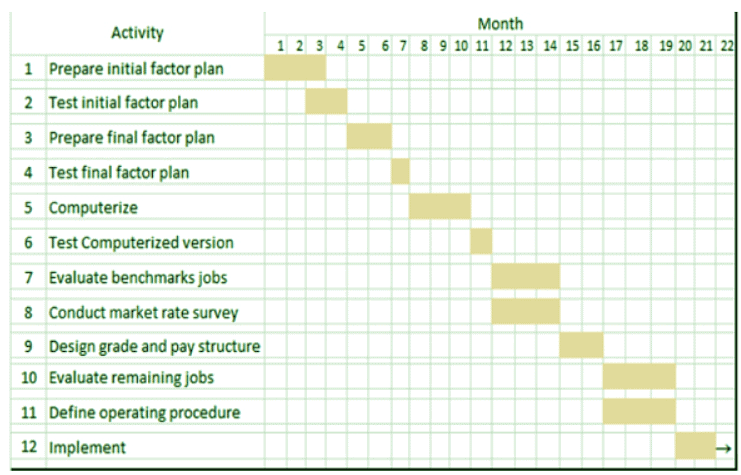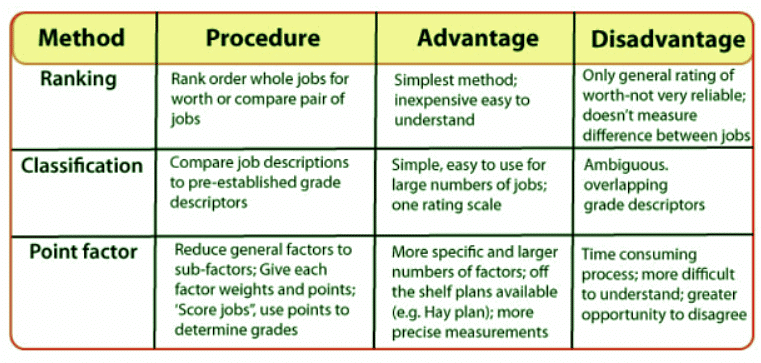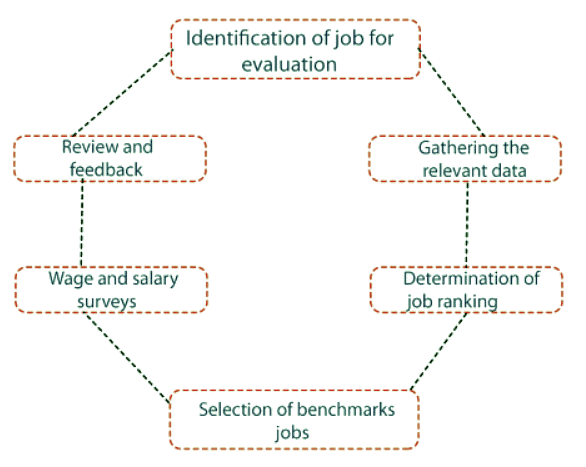Job Evaluation | Commerce & Accountancy Optional Notes for UPSC PDF Download
| Table of contents |

|
| Understanding Job Evaluation |

|
| Methods of Job Evaluation |

|
| Computer Assisted Job Evaluation |

|
| Process of Job Evaluation |

|
Understanding Job Evaluation
- Job evaluation is a process that aims to assess the relative value of a job within an organization by comparing it with other jobs both internally and in the broader job market. The primary goal is to systematically compare jobs to determine their relative worth, contributing to the establishment of a fair and logical pay structure. It's crucial to note that job evaluation is distinct from job analysis.
- While job analysis gathers information about a job systematically, job evaluation takes that information and assesses the job's relative value, ensuring equitable pay structures. In essence, job evaluation involves identifying, analyzing, and measuring each job against established criteria to consistently determine the relative value of jobs. Importantly, the purpose of job evaluation is not to secure a salary increase for the job incumbent.
- Job evaluation has several key objectives within an organization. These include establishing a clear and accurate relationship between each job and others in the organization, determining the appropriate wage rates for each job relative to others within the company, ensuring precise selection and fair treatment of employees through training, promotions, or transfers, fostering positive employee relations, boosting morale, and providing incentives. Additionally, job evaluation serves as a foundation for effective management control.
- Jobs undergo evaluation during various instances, such as when a new position is created, before recruitment, and when there is a significant change, typically around 10-15%, in an existing role.
A typical job evaluation programme

Methods of Job Evaluation
There are many methods by which job evaluation is done:
- Ranking/Grading Method: The ranking method involves arranging jobs in descending order of importance based on their job descriptions and specifications. A committee of experts, known as raters, is responsible for this ranking at the departmental level. This method is simple, easily understood, cost-effective, and suitable for small establishments. However, its limitations include potential inaccuracies due to differences in job complexities and reliance on raters' general knowledge, making it unsuitable for large companies with complex organizational structures.
- Factor Comparison/Weight-in-Money Method: In this approach, jobs are ranked based on common key elements, which are then weighted and assigned monetary values. Each job's total value is calculated by combining these monetary values. This method is more accurate and systematic than simple ranking but is complex, less explainable, and expensive. The inclusion of weightage and monetary values may introduce bias, making it challenging to implement and less widely used.
- Point Rating Method: This method evaluates each job individually, considering factors such as skill, effort, responsibility, and working conditions. These factors are combined to assign a single point score to each job. The advantages include an analytical approach and quantitative value for each job, with standardized guidelines in a user manual. However, drawbacks include the need for periodic manual updates, difficulty in application, and potential lack of clarity for workers.
Summary of job evaluation method

Computer Assisted Job Evaluation
Computers can play a direct role in aiding the job evaluation process, and various types of schemes exist for this purpose:
- Two primary categories of computer-assisted systems can be identified. The first category involves job analysis-based schemes, exemplified by Link Consultants, where job analysis data is either directly input into the computer or transferred from a paper questionnaire. Computer software utilizes predetermined rules, represented by an algorithm reflecting the organization's evaluation standards, to convert the data into scores for each factor and generate a total score. This algorithm mimics panel judgments on both job factor levels and overall job scores.
- The second category encompasses interactive schemes employing software like that provided by Pilat UK (Gauge). In these systems, the job holder and their manager sit in front of a computer and respond to a series of logically interconnected questions forming a question tree. The answers to these questions lead to scores for each built-in factor and a total score.
- Computer-assisted job evaluation offers several advantages. It ensures greater consistency as the same input information consistently yields the same output result due to the consistent application of the judgmental framework (algorithm). Additionally, it provides extensive database capabilities for sorting, analyzing, and reporting on input information and system outputs. Once the initial design is complete, this method accelerates the job evaluation process.
Process of Job Evaluation
The job evaluation process encompasses the following steps:
- Attaining approval from employees by elucidating the purpose and utility of the job evaluation program.
- Establishing a job evaluation committee comprising experienced employees, union representatives, and HR experts.
- Identifying the job to be evaluated, which should be representative of the type of work conducted within the organization.
- Analyzing and formulating a job description.
- Choosing an evaluation method that aligns with the job factors and organizational requirements.
- Categorizing jobs based on weightage and monetary values.
- Implementing the program organization-wide after thorough explanation to employees.
- Conducting periodic reviews in response to changes in the environment over time.
Job Evaluation Process
Conclusion
In summary, job evaluation involves determining the value of various jobs within an organization. It serves as a foundation for ranking or grading different jobs and constructing a corresponding pay structure. This process entails detailing the duties, authority relationships, skills, working conditions, and other pertinent information associated with jobs. Job evaluation is a crucial responsibility of human resource managers, aiming to assess the value or significance of each job within the organization.
|
196 videos|219 docs
|
FAQs on Job Evaluation - Commerce & Accountancy Optional Notes for UPSC
| 1. What is job evaluation? |  |
| 2. What are the methods of job evaluation? |  |
| 3. What is computer-assisted job evaluation? |  |
| 4. What is the process of job evaluation? |  |
| 5. How does job evaluation benefit organizations? |  |














